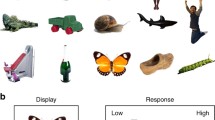Abstract
This paper presents a simple random procedure for selecting subsets of stimulus pairs for presentation to subjects. The resulting set of ratings from the group of subjects allows the construction of a group (average) space through the use of the computer program TORSCA-9 or equivalent programs. The procedure is applied to both real and simulated data. It is found that subjects need only make between 20% and 50% of the usual judgements to reconstruct a reasonably accurate group space.
Similar content being viewed by others
References
Lingoes, J. C. & Schöneman, P. H. Alternative measures of fit for the Schoneman-Carroll matrix fitting algorithm.Psychometrika, 1974,39, 423–427.
Spence, I. & Domoney, D. W. Single subject incomplete designs for non-metric multidimensional scaling.Psychometrika, 1974,39, 469–489.
Young, F. W. TORSCA-9: A Fortran IV program for nonmetric multidimensional scaling.Behavioral Science, 1968,13, 343–344.
Young, F. W. & Cliff, N. Interactive scaling with individual subjects.Psychometrika, 1972,37, 385–415.
Author information
Authors and Affiliations
Rights and permissions
About this article
Cite this article
Robinson, E.J., Lissitz, R.W. The approximation of a group stimulus space by averaging responses to selected subsets of the stimuli. Psychometrika 42, 447–450 (1977). https://doi.org/10.1007/BF02293663
Received:
Revised:
Issue Date:
DOI: https://doi.org/10.1007/BF02293663




